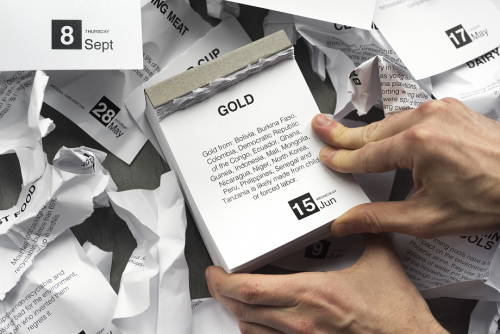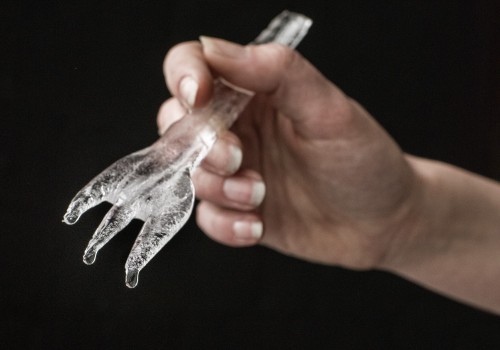By Claudia Marina
Within the design milieu, critical and interrogative design speaks loudly in modern times. It has to, for new ethical and environmental problems arise out of production, consumerism, and globalization on the daily. It is this notion that prompted designers like Krzysztof Wodiczko to claim that “instead of deconstructing itself, design should deconstruct life,” in his book Critical Vehicles. And with this framework in mind, designers have a responsibility to challenge and shed light on experiences and problems—even if the results are uncomfortable to deal with.
The idea of provocation in design is not new, but it is highlighted as an increasingly important factor. “Provocation is a tricky thing,” said Hans Otto Von Busch, associate professor of Integrated Design at the School of Design Strategies at Parsons School of Design. “Provocation gives voice to someone or something—usually that voice has been silenced. So provocation is unsettling, and it challenges something. The question for designers is how to be aware of what provokes, what voices are heard, and what agency provocation can have.”
Von Busch taught a graduate-level course appropriately titled Provocative Products this past Spring 2016 semester. The course was a collaboration between the MFA Industrial Design and MA Design Studies programs that brought students from both disciplines together to work on a series of “provotypes” and “provoprops” that were exhibited as part of the Parsons Festival taking place during NYCxDesign 2016. Historical examples of provocation in design as well as the students’ own projects are on view at the exhibition “Impact!” at the South Street Seaport from May 9 to June 10, 2016.
Danish interaction designer Preben Mogensen first used the term “provotype” in the ‘90s to describe a certain type of prototype that transgressed beyond traditional design principles and functioned to provoke new visions and possibilities among users. Though as the students began researching cases of provocation through design, they realized that these designs often operated within larger social structures that made transgression, enticement, and creativity possible. “We came up with the term ‘provoprops’ as material props that mobilize larger provocations. Gandhi’s use of DIY salt in the 1930 Salt March was a key example,” Von Busch said.
Both experienced designers and design thinkers examined the history of provocation in design and created designs centered on the theme of re-animating Earth Day. Exhibited were designs like Lisa Merk and Ari Elefterin’s “Melt,” a silicone mold to create ice cutlery meant to communicate the urgency of the earth’s melting ice caps. Refrigeration and ice production are regarded as one of the biggest perpetrators of global warming, according to the exhibition, and the resulting design “takes hold of these realities and speeds them up, communicating the urgency and translating it into an evocative and sometimes painful physical experience.”
MA Design Studies candidate Lisa Merk intended for “Melt” to be an experience for those interacting with her objects. “Participants are fed foods that would have been historically difficult to preserve or radically different in preparation without the advent of refrigeration. They are not given any alternate utensils throughout the duration of the meal,” she said.

“Guiltrip,” designed by MA Design Studies students Misha Volf, Estefanía Acosta de la Peña, and Laura Sanchez.
Misha Volf, Estefanía Acosta de la Peña, and Laura Sanchez, MA Design Studies, have a history in the program of collaborating together on various projects. This time, the trio created a tear-away desk calendar titled “Guiltrip,” which presents 365 facts meant to trigger “eco-guilt” based on the negative consequences our daily actions perpetrate. Each day has its word or phrase of the day—for example “World Cup”—followed by the provocation. For some, seeing the term World Cup means an event that happens every four years that places soccer/football on a global pedestal. For those tearing away at the pages of “Guiltrip,” it is reminded, “Brazil during the World Cup will produce the equivalent of 2.72 million metric tons of greenhouse gases.”
Merging practice and theory, Provocative Products relied on collaboration and innovation from all students. The challenge of bridging expert and non-expert design knowledge led to final projects that had a theoretical backbone and understanding as a result of researching in tandem with practical aesthetic claims. “The Design Studies program is definitely changing my view on design— Provocative Products is just one part of it. I have learned to research properly. I try to dive deeper into research with every project I am working on, which has led me to learn how to talk about design in a different way,” Merk said.
Von Busch admits that it’s still a challenge to bridge the two cultures, as when addressing a subject such as provocation, the theoretical part can easily fall into endless discussions. If taught again in the future, Von Busch said he would incorporate more elements of a hands-on approach early on.
The future of design lies in part in cross disciplinary collaboration, which breeds innovation, excitement, and better solutions—or in this case provocations. “ Let’s put it like this: design can be seen as creating leverage,” Von Busch said. “ Provocation can be part of it, if made well and implemented in a strategic way. It can make the weak become strong. Now, how does your design make the weak become strong?”

